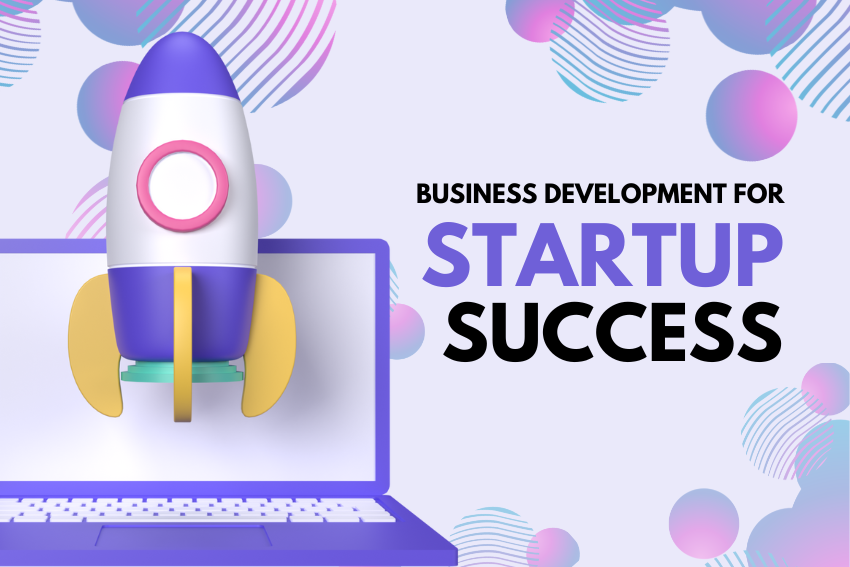Why should any startup care about business development when the product still needs polishing? Because between a cool prototype and a thriving company lies a messy stretch called growth. The bright idea alone won’t carry a team very far; what keeps the lights on is revenue, partnerships, and momentum.

Smart, deliberate business development gives young companies the lift they crave. Unlike a Fortune 500 with deep pockets and sprawling departments, a startup starts with little more than passion and a plan. Every deal, every handshake, every bit of focus count. This post discover proven business developmwnt strategies for startup success.
Understanding Business Development
People sometimes toss the words sales, marketing, and business development around as if they all mean the same thing. They really don’t. Business development is the bigger picture: spotting chances, forging connections, and stitching them together for lasting value.
In a startup, the title may land on a founder, a rookie hire, or even the intern who just graduated last week. That person quickly becomes a strategist, negotiator, calendar juggler, and constant tester of product-market fit. When done right, business development is the engine that propels the whole vehicle forward. Getting clear on what it actually is helps small teams rank their to-do lists and tune out the shiny distractions.
20 Ways Business Development Drives Startup Success
Business development is a significant aspect in conversion of a startup idea into a successful business. This article explores business development strategies that may help startups to promote growth, establish good relations and attain sustained success.
Market Research and Customer Insights
Smart founders look outward before they build. Market research spots the holes in an industry and unearths what real people want. Surveys, competitor check-ups, and a quick scan of trending hashtags turn gut feelings into facts. Actionable customer insights breathe life into a company mission or unique value pitch. Without this homework, many startups waste energy on products nobody asks for.
Creating a Scalable Business Model
Winning growth never comes free; the trick is to stretch profits, not headaches. Startups that sketch a scalable business model early keep their headaches mild. Pricing tiers, subscriptions, and freemium hand out value but keep room to charge. Small expenses plus swelling sales mean bigger margins, not bigger chaos. Business development then polishes that framework, tweaking it after every customer conversation.
Building Strategic Partnerships
Most new companies are small, and that means they usually lack an in-house team for every need. A well-chosen partnership can fill in those missing pieces. Think of a tech plugin, a distribution handshake, or even a co-branded ad. Business-development pro are the ones who chase down those deals.
When one online seller hooked up the WooCommerce product video plugin, sales shot up, and customers got to see merchandise in action. Fast growth like that often happens because someone dares to connect the dots. Pinpointing, then nurturing loyal partners, quickly turns into the go-to move for any startup crew that wants to scale.
Developing a Strong Value Proposition
Why should a customer click buy on your page instead of the one next door? The answer lies in the value proposition. A good one lays out not just features, but mood-lifting benefits people can picture.
Startup founders test, tweak, and repeat that sentence every week. Sales teams read it; marketing teams splash it across banners; investors ask for it by name. Business development keeps the line fresh, swapping stale wording when new customer feedback rolls in. If the pitch doesn’t evolve, the company stops growing, too.
Customer Acquisition and Retention Strategies
Landing fresh customers and keeping them around is the lifeblood of any new company. Business development pros sketch the full roadmap. Most people start by hearing an exciting podcast episode, discovering a viral TikTok, or falling for a colorful banner ad. That first bump is called acquisition.
Once folks sign up, the focus flips. Emails, birthday discounts, and surprise thank-you messages make sure buyers feel noticed. Shoppers who return often spend more than greenhorns do, so loyalty gets a gold star.
To keep the plan sharp, founders trace each buyer step, spot rough patches, and smooth them over. That homework stretches customer lifetime value and turns one-time buyers into brand fans.
Measuring and Adapting the Strategy
Business development never sleeps; the strategy runs on a loop. Founders Yank reports every month, counts wins, and ditches what flops. Common gauges are the cost to snare one customer, how much cash they cough up over the years, and which partner links pay off.
Numbers shine a light; guesses fade. Software dashboards and speedy feedback let teams swerve before big bills stack up. A bendable game plan doesn’t just help a startup survive-it keeps it one step ahead when markets shake.
Using Technology to Streamline Business Development
Modern software can supercharge outreach in minutes. Customer management apps, bulk email helpers, and number-crunching dashboards all work together to trim wasted time. A product-video plugin for WooCommerce, for instance, makes listings pop and reel shoppers in. Founders should hunt for lightweight fixes that automate the boring stuff. The perfect tech mix frees brains for ideas that really drive sales.
Hiring the Right Team for Business Development
Most founders eventually need partners who can chase deals full-time. Hiring the right crew turns chaos into clear wins. Candidates must be strategic, flexible, and able to explain big concepts in plain language. They should thrive in uncertainty and spot opportunities others miss. Just one savvy hire can break into a new region or line up life-saving funding. Betting on great people keeps growth on its upward curve.
Overcoming Common Challenges in Business Development
Every young company hit bumps in the road, from tight cash flow to having almost no one recognize its name. Smart business development searches for offbeat fixes rather than Price Wars. Maybe a brand adds a quirky feature customer swear by, or it surprises folks with service that feels personal. When the calendar flips and another rejection email arrive, the rep shrugs, learns, and gears up for the next call. Resilience isn’t just a buzzword; it’s the everyday armor of anyone trying to grow a startup.
Securing Funding Through Strategic Business Development
Money is oxygen for a fresh business, and securing it is half-strategy, half-sweat. Angels, venture funds, or even a local grant program usually want to see polish before they pull out a checkbook. A crisp pitch deck, real user numbers, and a roadmap that doesn’t vanish after 12 months do the trick—strong connections in the room help, but clear, honest talk seals the deal. When founders and developers speak the same language, “We can trust this team” stops being a guess and starts looking like obvious logic.
Exploring Global Expansion Opportunities
When a startup really picks up speed, looking beyond the border suddenly feels possible. International markets can turn a local hit into a worldwide brand. Business development crews dive into research, scouting countries that match the company’s vibe. They chew over which entry route makes sense- a soft launch, full-on wholesale, or maybe teaming up with a local distributor. Culture, currency, and, yes, all the fine-print regulations sit front and center on the planning board. Messing up any of those could turn a bright idea into a painful lesson. A solid global strategy feels hectic on the whiteboard yet exhilarating in practice, and the biz dev team usually bridges that gap.
Integrating Customer Feedback into Product Development
That one-star review you dread can hide a five-star idea. Customer feedback is raw, sometimes brutal, but often brilliant. Biz dev people gather those snapshots and pass them to engineers and designers like treasure maps. Small tweaks here, bigger upgrades there, and the product inches closer to what real users crave. Each cycle of listening, learning, and launching builds loyalty and keeps competitors glancing nervously over their shoulders. In a marketplace that never sleeps, that extra edge can pay off in sales and brand love.
Building a Community Around Your Brand
A thriving brand fan club beats any paid ad banner. When customers feel seen, they pull friends in without being asked. Startups that host casual Q&A sessions post how-to videos and reply on Twitter often watch retention numbers climb. A forum buzzing with user tips becomes a living help desk and a sales funnel at once. Building that atmosphere doesn’t happen by accident; biz dev pros plan the events, set the tone, and keep the dialogue going. In return, the community hands back ideas, loyalty, and candid market intel-no invoice required.
Aligning Sales and Marketing with Business Development
Sales and marketing rarely hit their targets in a vacuum. When those teams partner with business development, the same story shows up in email blasts, social posts, and sales pitches. Shared goals pull everyone in the same direction, so prospects hear one voice instead of three conflicting ones. That clarity often boosts conversion rates and gives the brand a more polished look.
Scaling Operations Alongside Growth
A booming customer list does nothing for a startup if shipping windows stay the same. Business development must talk to ops managers about inventory, delivery routes, and support staff before the orders even land. Grow the back end slowly, and you dodge service meltdowns; go too fast, and resources leak away like air from a balloon. A balanced scaling plan keeps promises while preventing waste.
Leveraging Data to Drive Smart Decisions
These days, instincts alone won’t keep a company afloat; numbers fill in the blanks. Customer clicks, sales cycles, and even what rival firms are up to all end up on a dashboard that begs for attention. By watching those KPIs unfold in real-time, founders can tweak campaigns instead of rewriting them weeks later. A data-heavy approach clears out the guesswork and nudges results in the right direction.
Establishing a Strong Brand Identity
A startup needs a brand that’s easy to spot in a crowded market. A clean logo, friendly tone, and short, honest mission statement go a long way. Business development checks that the website, social feeds, sales, and anything that talks to customers are the same thing. When the look and feel match the promise of the product, trust grows fast. That trust gives marketing a boost and helps close deals.
Creating Educational Content for Lead Generation
People love to learn before they buy, and free guides scratch that itch. Short blog posts, downloadable eBooks, live anything useful can pull in curious visitors. Business dev can partner with marketing to make sure the material speaks to the right audience and shows real know-how. Over time, those readers turn into warm leads who already believe the company delivers value.
Monitor the Competitive Landscape
In a crowded marketplace, sitting still is a fast lane to failure. Regularly peeking over the fence lets you see how rivals lure customers, what shiny new offerings they’ve rolled out, and where the entire industry is shifting.
Even slight tech tweaks or sudden swings in buyer taste can flip your position overnight. Your business development crew gathers those breadcrumbs and pivots pricing, product features, or marketing angles before the competition blinks. Eyeing the horizon keeps you nipping at opportunities instead of chasing problems.
Set Long-Term Strategic Vision
Quick wins like bumping monthly sales numbers are rewarding, but they’re sugar rushes without a hearty meal behind them. A crystal-clear, long-range vision tells everyone where the highway is actually headed instead of just counting potholes.
Researching slow-moving trends, listening to evolving customer desires, and hunting for white-space partnerships fuels that roadmap. It might steer the company into fresh geographies, link up with a surprising ally, or spark an entirely new product line. A sturdy, forward-looking plan steadies the ship when today’s waters get choppy.
Conclusion
Business development is not just a fancy title on an org chart. It turns open ideas into concrete partnerships and pushes plans into the real world. When a startup treats biz dev as its backbone, growth paths get clearer, and customer satisfaction follows. Every tiny choice, from feature tweaks to alliance talks, pushes the company toward its goals. Following these steps won’t magically create success, but they will lay down tracks that lead there. Done right, business development becomes the engine behind every breakthrough.


